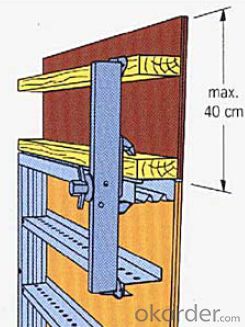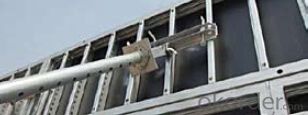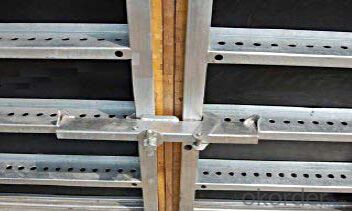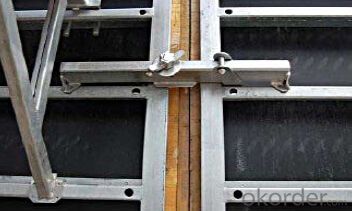Steel-Frame Formwork System Link Part
- Loading Port:
- China Main Port
- Payment Terms:
- TT OR LC
- Min Order Qty:
- -
- Supply Capability:
- -
OKorder Service Pledge
OKorder Financial Service
You Might Also Like
Steel-frame Formwork SF-140
Characteristics:
◆ Few parts for fast forming.
◆ Max. Concrete pressure: 80KN/m2.
◆ Hot-dip galvanized steel frame.
◆ The thickness of plywood is 18mm & the panel is 14cm.
◆ Compatibility with Hunnebeck Manto system due to similar edge profile.
System Details & Application:
◆ Neat joint and fast assembling with aligning panel clamp.
◆ Flexible panel arrangement and height extension.
◆ The selection of panels.
◆ Kinds of panel connectors.
◆ Corner clamp application.
◆ Length adjustment application.
◆ Height adjustment & aligning strut.
◆ Walkway bracket & platform.



- Q: What are the common challenges faced during steel formwork reassembly?
- During steel formwork reassembly, there are several common challenges that can arise. One of the main challenges is ensuring proper alignment and placement of the formwork components. This includes correctly positioning the steel panels, braces, and connecting rods to ensure they are level and secure. Another challenge is managing the weight and size of the steel formwork components. Steel panels and beams can be heavy and bulky, making it difficult to maneuver and assemble them properly. This requires careful planning and coordination to ensure the safe handling and positioning of these components. Additionally, the complexity of the formwork design can pose challenges during reassembly. Steel formwork systems can be intricate and include various interlocking components and connections. It is crucial to understand the design and assembly instructions to properly reassemble the formwork and ensure its stability and strength. Proper sequencing and timing are also important challenges during steel formwork reassembly. The order in which the formwork components are assembled can impact the overall efficiency and effectiveness of the construction process. It is essential to plan the reassembly carefully and coordinate with other construction activities to avoid delays and ensure smooth progress. Finally, safety is a significant challenge during steel formwork reassembly. Working with heavy steel components can present risks for workers, including the potential for injuries due to falls, lifting accidents, or structural failures. Therefore, it is crucial to have proper safety measures in place, such as using appropriate lifting equipment, providing personal protective equipment, and ensuring workers are trained on safe assembly procedures. Overall, steel formwork reassembly requires careful planning, coordination, and attention to detail to overcome challenges related to alignment, weight, complexity, sequencing, and safety. By addressing these challenges effectively, construction projects can proceed smoothly and efficiently.
- Q: What are the common quality control measures for steel formwork?
- Common quality control measures for steel formwork include: 1. Visual Inspection: This involves a thorough examination of the steel formwork to check for any visible defects or damage. Any signs of cracks, dents, or deformations should be identified and addressed. 2. Dimensional Accuracy: The dimensions of the steel formwork, such as the length, width, and height, should be measured and compared to the specified requirements. Any deviations from the required dimensions should be corrected. 3. Material Testing: Steel formwork should undergo material testing to ensure that it meets the required standards and specifications. This may involve testing the tensile strength, yield strength, hardness, and chemical composition of the steel. 4. Welding Inspection: If the steel formwork is welded, the quality of the welds should be inspected. This includes checking for proper penetration, fusion, and the absence of any defects like cracks or porosity. Non-destructive testing methods like ultrasonic or radiographic testing can be employed to ensure the integrity of the welds. 5. Surface Coating Inspection: The surface coating of the steel formwork, such as paint or galvanized coating, should be inspected for its thickness, adhesion, and uniformity. This ensures protection against corrosion and enhances the durability of the formwork. 6. Load Testing: Steel formwork should be subjected to load testing to evaluate its structural integrity and load-bearing capacity. This involves applying a known load to the formwork and monitoring its response to ensure it can safely support the required loads during construction. 7. Documentation and Record Keeping: Quality control measures should be documented and records should be maintained for future reference. This includes recording the inspection results, material test reports, and any corrective actions taken. These quality control measures help to ensure that steel formwork meets the required standards, specifications, and safety regulations, ultimately ensuring the structural integrity and performance of the formwork during construction.
- Q: How does steel formwork affect the overall energy efficiency of the structure?
- Steel formwork can have a significant impact on the overall energy efficiency of a structure. One of the main benefits of using steel formwork is its ability to provide a high level of thermal insulation. Steel has a low thermal conductivity, meaning it does not easily transfer heat. This property helps to minimize heat loss or gain through the walls, floors, and ceilings of the structure. By using steel formwork, the building envelope can be better sealed, reducing air infiltration and improving the overall airtightness of the structure. This prevents unwanted air leakage, which can lead to energy loss and reduced energy efficiency. Steel formwork also allows for better control of moisture and humidity levels, which is crucial for maintaining a comfortable indoor environment and preventing mold or moisture-related issues. Additionally, steel formwork provides a durable and long-lasting construction solution. It can withstand extreme weather conditions, seismic activities, and other external forces, ensuring the structural integrity of the building for many years. This durability reduces the need for frequent repairs or replacements, which can save energy and resources in the long run. Furthermore, steel formwork is a sustainable choice as it is often made from recycled materials and is itself recyclable at the end of its lifespan. The use of recycled steel reduces the carbon footprint associated with construction and helps conserve natural resources. The recyclability of steel formwork also means that it can be repurposed or reused in future projects, further reducing waste and environmental impact. In summary, steel formwork positively affects the overall energy efficiency of a structure by providing excellent thermal insulation, improved airtightness, moisture control, durability, and sustainability. By choosing steel formwork, builders can create energy-efficient buildings that are environmentally friendly and cost-effective in the long term.
- Q: Can steel formwork be used in coastal or marine construction projects?
- Yes, steel formwork can be used in coastal or marine construction projects. Steel formwork is known for its durability and strength, making it a suitable choice for projects in harsh environments such as coastal or marine areas. Its resistance to corrosion allows it to withstand the corrosive effects of saltwater and other coastal elements. Additionally, steel formwork can be easily reused and recycled, making it a cost-effective and sustainable option for coastal or marine construction projects.
- Q: How does steel formwork handle different concrete surface protection methods?
- Steel formwork is a versatile and durable option for constructing concrete structures, and it can easily handle different concrete surface protection methods. The formwork itself is typically made of steel plates or frames that provide a strong and rigid support structure for the wet concrete. When it comes to protecting the concrete surface, there are various methods that can be employed, such as applying surface coatings, using form release agents, or using various types of form liners. Steel formwork can easily accommodate these methods and ensure their effectiveness. For instance, if a surface coating is being applied to protect the concrete, steel formwork can provide a smooth and uniform surface that allows for even and consistent application of the coating. The steel formwork is resistant to damage from the coating materials and can withstand the pressure and weight of the wet concrete while the coating cures. Similarly, when using form release agents, steel formwork can ensure proper adhesion and prevent any sticking or bonding between the concrete and the formwork. The smooth and non-porous surface of steel formwork allows for easy application and removal of the form release agents, ensuring a clean and protected concrete surface. Furthermore, steel formwork can accommodate the use of various types of form liners, which are used to create decorative or textured finishes on the concrete surface. The form liners can be easily attached to the steel formwork to create the desired texture or pattern, and the sturdy nature of steel ensures that the form liners remain securely in place during the pouring and curing process. In summary, steel formwork is highly compatible with different concrete surface protection methods. Its strength, durability, and versatility allow for easy application of coatings, form release agents, and form liners, ensuring a well-protected and aesthetically pleasing concrete surface.
- Q: How does steel formwork affect the construction timeline?
- Steel formwork can have a significant impact on the construction timeline in both positive and negative ways. One of the main advantages of using steel formwork is its durability and strength. Unlike traditional wooden formwork, steel formwork can withstand multiple uses without losing its structural integrity. This means that it can be reused many times, reducing the time and effort required to set up formwork for subsequent construction phases. Additionally, steel formwork allows for faster assembly and disassembly, which can help to expedite construction timelines. Furthermore, steel formwork provides a high level of accuracy and consistency in shaping concrete structures. The precise dimensions and smooth finish achieved with steel formwork ensure that the construction process proceeds smoothly without any delays caused by rework or adjustments. This can lead to faster completion of construction projects. On the other hand, steel formwork can also introduce certain challenges that may affect the construction timeline. Firstly, steel formwork is generally heavier and requires more effort to transport and handle compared to other types of formwork. This may slow down the overall construction process, especially if there are limitations in terms of available equipment or labor. Additionally, steel formwork may require additional time for installation and dismantling compared to other formwork systems. The complexity of steel formwork systems and the need for skilled workers to handle them can result in a longer setup and removal time. This can impact the overall construction timeline, particularly when tight deadlines need to be met. In conclusion, steel formwork can have both positive and negative effects on the construction timeline. Its durability, reusability, and accuracy can help expedite the construction process. However, the weight and complexity of steel formwork may introduce additional challenges that can potentially slow down the construction timeline.
- Q: How does steel formwork contribute to the overall sustainability of the construction industry?
- Steel formwork contributes to the overall sustainability of the construction industry in several ways. Firstly, steel formwork is highly durable and can be reused multiple times, reducing the need for new materials and minimizing waste. This not only reduces the environmental impact of construction but also lowers costs for builders. Additionally, steel formwork allows for precise and efficient construction, resulting in less material wastage and overall resource savings. Lastly, the strength and versatility of steel formwork enable the construction of more durable and long-lasting structures, reducing the need for frequent repairs or replacements, which further contributes to the sustainability of the construction industry.
- Q: How does steel formwork differ from other types of formwork?
- Steel formwork differs from other types of formwork in several ways. Firstly, steel formwork is highly durable and can be used multiple times, whereas other types of formwork such as wood or plywood may need to be replaced after a few uses. Additionally, steel formwork provides a smooth and precise finish, resulting in high-quality concrete structures. It also offers a higher load-bearing capacity, allowing for the construction of larger and more complex structures. Moreover, steel formwork can be easily fabricated and assembled, reducing construction time and labor costs. Overall, steel formwork is a more robust, efficient, and cost-effective solution compared to other types of formwork.
- Q: What are the different types of coatings used on steel formwork?
- There are several different types of coatings commonly used on steel formwork, including epoxy coatings, polyurethane coatings, and zinc coatings. Epoxy coatings provide excellent adhesion and corrosion resistance, making them suitable for various applications. Polyurethane coatings offer durability and resistance to abrasion, making them ideal for heavy-duty use. Zinc coatings, such as galvanization, provide excellent corrosion protection by forming a protective layer on the steel surface. Each type of coating has its own unique properties and is chosen based on the specific requirements of the project.
- Q: How does steel formwork affect the overall durability of a structure?
- The durability of a structure can be greatly influenced by steel formwork. Steel formwork is known for its strength and durability, which provides excellent support and stability during the construction process. This ensures accurate construction according to required specifications, which is vital for long-term durability. Using steel formwork offers several advantages. It has the ability to withstand high pressures and loads, which is especially important in large-scale construction projects involving heavy concrete pours. The steel formwork effectively distributes the weight and pressure exerted by the concrete, preventing any deformation or collapse. This helps maintain the structure's integrity and durability over time. In addition, steel formwork is highly resistant to environmental factors such as moisture, humidity, and temperature changes. This resistance protects the structure from potential damage such as corrosion, rot, or warping, enhancing its overall durability. This reduces the need for expensive repairs or maintenance. Furthermore, steel formwork provides a smooth and even surface for the concrete to adhere to during the curing process. This results in a uniform and consistent finish, reducing the risk of cracks or weak points in the structure. This absence of defects improves the structure's durability, as it is less prone to structural weaknesses that can compromise its integrity over time. Moreover, steel formwork is reusable and can be easily dismantled and reassembled for multiple construction projects. This not only reduces construction costs but also minimizes waste and environmental impact. The ability to reuse steel formwork ensures consistent use of high-quality materials, contributing to the structure's long-term durability. In conclusion, steel formwork plays a significant role in determining the overall durability of a structure. Its strength, resistance to environmental factors, ability to distribute loads, and provision of a uniform finish all contribute to the long-term durability and structural integrity of the building. By utilizing steel formwork, builders can ensure that the structure is built to last, minimizing the need for future repairs or replacements.
Send your message to us
Steel-Frame Formwork System Link Part
- Loading Port:
- China Main Port
- Payment Terms:
- TT OR LC
- Min Order Qty:
- -
- Supply Capability:
- -
OKorder Service Pledge
OKorder Financial Service
Similar products
Hot products
Hot Searches
Related keywords






















